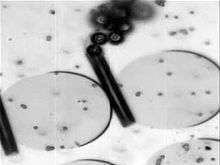Micropump


Although any kind of small pump is often referred to as micropump, a more accurate definition restricts this term to pumps with functional dimensions in the micrometre range. Such pumps are of special interest in microfluidic research, and have become available for industrial product integration in recent years. Their miniaturized overall size, potential cost and improved dosing accuracy compared to existing miniature pumps fuel the growing interest for this innovative kind of pump.
Types and technology
First true micropumps were reported in the mid-1970s,[3] but attracted interest only in the 1980s, when Jan Smits and Harald Van Lintel developed MEMS micropumps.[4] Micropumps have a great potential for bio-inspired applications e.g. a flexible electromagnetic micropump using Magnetorheological elastomer to replace lymphatic vessels.[5]
Within the microfluidic world physical laws change their appearance:[6] As an example, volumetric forces, such as weight or inertia, often become negligible, whereas surface forces can dominate fluidical behaviour, especially when gas inclusion in liquids is present. With only a few exceptions, micropumps rely on micro-actuation principles, which can reasonably be scaled up only to a certain size.
Micropumps can be grouped into mechanical and non-mechanical devices:[7] Mechanical systems contain moving parts, which are usually actuation and valve membranes or flaps. The driving force can be generated by utilizing piezoelectric, electrostatic, thermo-pneumatic, pneumatic or magnetic effects. Non-mechanical pumps function with electro-hydrodynamic, electro-osmotic, electrochemical [8] or ultrasonic flow generation, just to name a few of the actuation mechanisms that are currently studied.
Additionally, chemically powered non-mechanical pumps have been fabricated by affixing nanomotors to surfaces, driving fluid flow though chemical reactions. A wide variety of pumping systems exist ranging from biological enzyme based pumps,[9] to organic photocatalyst pumps,[10] to metal catalyst pumps.[11] These pumps generate flow through a number of different mechanisms including self-diffusiophoresis, electrophoresis, bubble propulsion and the generation of density gradients.[12]
See also
References
| Wikimedia Commons has media related to Micropumps. |
- ↑ Solovev, Alexander A.; Sanchez, Samuel; Mei, Yongfeng; Schmidt, Oliver G. (2011). "Tunable catalytic tubular micro-pumps operating at low concentrations of hydrogen peroxide". Physical Chemistry Chemical Physics. 13 (21): 10131. doi:10.1039/C1CP20542K. PMID 21505711.
- ↑ Chiu, S. H.; Liu, C. H. (2009). "An air-bubble-actuated micropump for on-chip blood transportation". Lab on a Chip. 9 (11): 1524–33. doi:10.1039/B900139E. PMID 19458858.
- ↑ Thomas, L.J. and Bessman, S.P. (1975) "Micropump powered by piezoelectric disk benders", U.S. Patent 3,963,380
- ↑ Woias, P (2005). "Micropumps – past progress and future prospects". Sensors and Actuators B. 105 (1): 28–38. doi:10.1016/j.snb.2004.02.033.
- ↑ Behrooz, M. & Gordaninejad, F. (2014). "A flexible magnetically-controllable fluid transport system". Active and Passive Smart Structures and Integrated Systems 2014. Active and Passive Smart Structures and Integrated Systems 2014. 9057. pp. 90572Q. doi:10.1117/12.2046359.
- ↑ Order from Chaos, The CAFE Foundation
- ↑ Abhari, Farideh; Jaafar, Haslina & Yunus, Nurul Amziah Md (2012). "A Comprehensive Study of Micropumps Technologies" (PDF). International journal of electrochemical science. 7 (10): 9765–9780.
- ↑ Neagu, C.R.; Gardeniers, J.G.E.; Elwenspoek, M.; Kelly, J.J. (1996). "An electrochemical microactuator: principle and first results". Journal of Microelectromechanical Systems. 5 (1): 2–9. doi:10.1109/84.485209.
- ↑ Sengupta, S.; Patra, D.; Ortiz-Rivera, I.; Agrawal, A.; Shklyaev, S.; Dey, K. K.; Córdova-Figueroa, U.; Mallouk, T. E.; Sen, A. (2014). "Self-powered enzyme micropumps". Nature Chemistry. 6 (5): 415–422. doi:10.1038/nchem.1895. PMID 24755593.
- ↑ Yadav, V.; Zhang, H.; Pavlick, R.; Sen, A. (2012). "Triggered "On/Off" Micropumps and Colloidal Photodiode". Journal of the American Chemical Society. 134 (38): 15688–15691. doi:10.1021/ja307270d. PMID 22971044.
- ↑ Solovev, A. A.; Sanchez, S.; Mei, Y.; Schmidt, O. G. (2011). "Tunable catalytic tubular micro-pumps operating at low concentrations of hydrogen peroxide". Physical Chemistry Chemical Physics. 13 (21): 10131–10135. doi:10.1039/c1cp20542k. PMID 21505711.
- ↑ Yadav, V.; Duan, W.; Butler, P. J.; Sen, A. (2015). "Anatomy of Nanoscale Propulsion". Annual Review of Biophysics. 44 (1): 77–100. doi:10.1146/annurev-biophys-060414-034216. PMID 26098511.